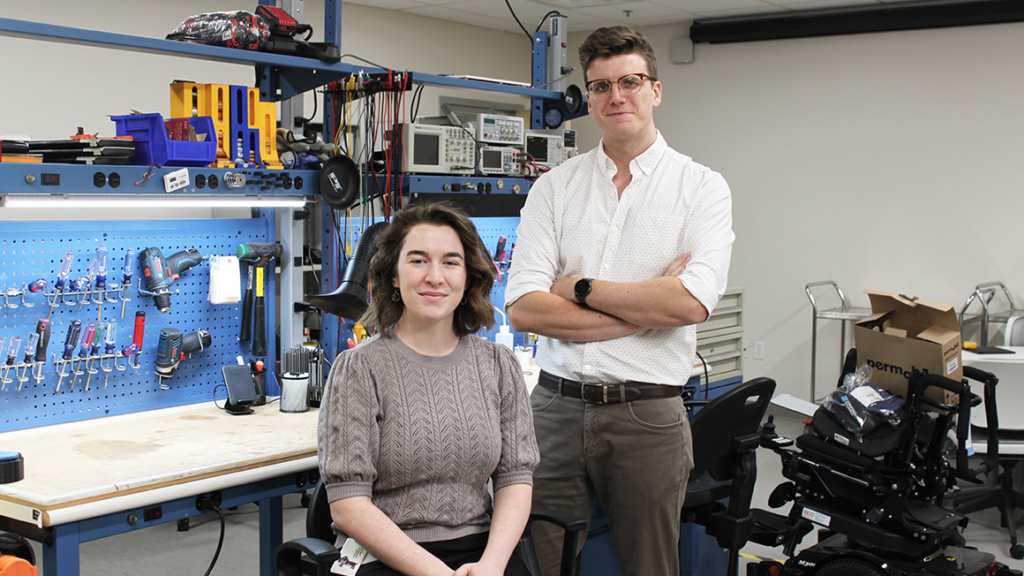
At the heart of life-changing innovations in assistive technology are dedicated electronic engineers. Please meet two Manitoba treasures, Shea Hunt and Rowen Guncheon. Working at the Rehabilitation Centre for Children (RCC), these individuals play a crucial role in creating devices to support youth living with disabilities, enhancing their ability to interact with the world. With backgrounds in engineering, a passion for accessibility and the unwavering support of the Children’s Rehabilitation Foundation (CRF), Hunt and Guncheon are transforming lives, one design at a time.
Both Hunt and Guncheon were drawn to engineering early in life. Hunt credits his interest in assistive technology to his mother who helped foster an early fascination with accessibility for children.
“My mother worked with children living with disabilities and needed toys adapted for her clients,” reminisces Hunt. “This allowed me to channel my habit of dismantling and modifying electronics into switch-adapting toys for her and her clients.”
Guncheon’s journey was similar yet driven by personal experience with accessibility challenges. At a young age, her love for disassembling and understanding how items work inspired an interest in engineering. A medical procedure during university intensified this focus, revealing firsthand the struggles people face in inaccessible environments.
“I underwent orthopedic surgery and had a long recovery,” shares Guncheon. “I needed to use a knee scooter, which was a nightmare. I wore the brakes out almost immediately and had a lot of trouble getting around. It really made me realize how inaccessible my environment was. I spent a lot of time thinking about how I could use what I was learning in class to improve my situation and similar situations people face every day.”
Day in the Life: Engineering with Impact
At RCC, the work of an electronic engineer goes beyond traditional tech design. Hunt comments their most important responsibility is to design and build assistive technology. RCC electronic engineers work closely with therapists, mechanical engineers, clinical technologists, and other specialists to create unique, client-centered devices, ranging from switch-adapted toys to complex motorized tools such as a dodgeball launcher.
Physiotherapist Ambrose Cox, who works alongside Hunt and Guncheon in Assistive Technology, is grateful for their dedication and expertise.
“I consider myself fortunate to have the opportunity to work with such a bright and motivated group with the common goal of improving the quality of life for our clients,” said Cox.
This collaboration means no two days are the same and each project is an opportunity to address a new challenge. Guncheon notes her role involves participating in assessments for augmentative and alternative communication devices, designing smart home accessibility tools and contributing to research projects. It’s an environment where continuous learning is essential, keeping engineers sharp and responsive to their clients’ evolving needs.
Highlights and Challenges: Designing for Smiles
One of the highlights of their roles is seeing how their work impacts others. Hunt recalls a memorable moment involving a switch-adapted water cannon.
“I accidentally left some water in the tank, and as soon as the client activated the switch, everyone was soaked! We all had a good laugh,” he shares.
Guncheon also cherishes a special memory of a power wheelchair trial. The client used the chair’s elevation feature to reach new heights and interact with parts of the clinic and world previously out of reach, creating a sense of joy and empowerment, leaving a lasting impression. These experiences underscore the meaningful connections and joy assistive technology can bring, helping people do things they may not have been able to otherwise.
Working at RCC has sharpened Hunt and Guncheon’s awareness of accessibility challenges, noticing barriers everywhere from large steps to inaccessible sidewalks. This awareness has motivated Hunt to volunteer in his community to help improve accessibility. Guncheon sees technology and accessibility from a new perspective, valuing environments which enhance usability for people of all ages and abilities. This broader understanding of accessibility impacts their work and lives outside RCC.
The Role of CRF: Turning Ideas into Reality
CRF’s support has been transformative for both young engineers. The Foundation’s contributions fund essential projects providing direct benefits to the children they serve. Among these are the Kids on Wheels on-time mobility program and the Smart Suite, which bring innovative solutions to life in family homes.
“The equipment and design work funded by CRF have such a profound impact,” Guncheon says, “There’s nothing like seeing a child do something for the very first time, and CRF makes this possible.”
Looking Forward: Engineering Accessibility for All
Hunt and Guncheon embody the spirit of innovation and empathy which defines RCC’s approach to assistive technology. Their journeys reveal how a career in engineering can become a pathway to meaningful impact, improving lives through accessible, client-focused solutions.
Thanks to the generosity of donors across our province and a collaborative team, these engineers continue to break down barriers, one project at a time. As accessibility advocates, they are committed to a future where technology meets the needs of all individuals, creating a world where everyone can thrive.

